St Andrew Bobola Church, Hammersmith
St Andrew Bobola Church, Hammersmith also known as the Polish Church in Shepherd's Bush is a Roman Catholic parish church serving the Polish community in West London. The building was designed in Gothic Revival style by Edmund Woodthorpe, and stands at 1, Leysfield Road, Shepherd's Bush, in the Borough of Hammersmith and Fulham.
| St Andrew's Polish RC Church | |
|---|---|
| St Andrew Bobola Polish Roman Catholic Church | |
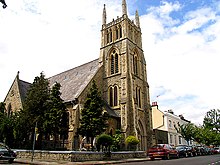 St Andrew Bobola Church in Leysfield Road | |
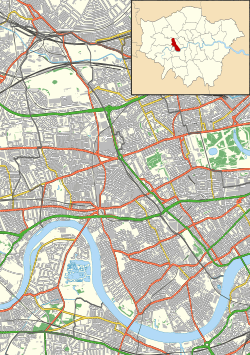 St Andrew's Polish RC Church  St Andrew's Polish RC Church | |
| 51.5009°N 0.2378°W | |
| Location | 1, Leysfield Road Shepherd's Bush, W 12 London Borough of Hammersmith and Fulham |
| Country | United Kingdom |
| Denomination | Roman Catholic |
| Website | https://parish.rcdow.org.uk/polishchurch/ |
| History | |
| Former name(s) | St Andrew's Presbyterian Church |
| Status | Active |
| Founded | 1869 |
| Founder(s) | Divisional general Archbishop Józef Gawlina in 1962 |
| Dedication | St. Andrew Bobola |
| Architecture | |
| Functional status | Parish Church |
| Architect(s) | Edmund Woodthorpe |
| Style | Gothic Revival |
| Groundbreaking | 1869 |
| Completed | 1870 |
| Closed | 1960 |
| Administration | |
| Parish | West London Polish Community |
| Archdiocese | Westminster |
| Province | Polish Catholic Mission |
| Clergy | |
| Archbishop | Most Rev. Vincent Nichols |
| Priest in charge | Fr. Marek Reczek |
History
The church, originally founded in 1869 for the Scottish Presbyterian community, was dedicated to St Andrew the Apostle, patron of Scotland. It was constructed in the then fashionable Neo Gothic style as laid out by architect Woodthorpe (1814-1887).[1] It was consecrated in 1870. With the passage of time, the congregation declined and in circa 1960 it was decided to amalgamate it with a more active presbyterian parish elsewhere. The church authorities therefore sought to dispose of their asset to another Christian faith community. In 1961 the church was bought by the Polish Catholic Mission to the United Kingdom, with a mortgage, paid off in time with the help of donations and legacies from the faithful.[2]
The church was re-dedicated in 1962, this time to another St Andrew in the Archdiocese of Westminster. Historically, it became only the second Catholic church to serve the capital's Polish community.[3]. The first Polish church in London was opened in Devonia Road, Islington, dedicated to Our Lady of Częstochowa and St Casimir. It became the first Polish-owned ecclesiastical building in the British Isles. It was consecrated on 30 October 1930 by cardinal August Hlond, primate of Poland in the presence of Cardinal Bourne of Westminster.
The Bobola congregation in West London was initially made up largely of people who had survived the trials of Siberia during and after World War II. It also served unofficially, as a Garrison Church for the thousands of Polish veterans, who had fought with the allies and were deprived of the right to return to their Polish homeland, surrendered to the USSR under the Yalta Agreement. From 1961 to 1979 fr. Kazimierz Sołowiej (1912–1979) was the parish priest. He took charge of the refurbishment of the building.[4] Despite an "uneventful" exterior, the interior of the church was, according to Bridget Cherry, "daringly modernised" by émigré Polish craftsmen and artists under the direction of designer Aleksander Klecki.[5] It contains many items inspired by Polish art and religious devotions.
To the left of the entrance is the Lady chapel dedicated to Our Lady of Kozielsk, whose original image in Poland was crowned by Pope John Paul II in 1997.[6]
The church is considered a building of architectural heritage.[7] It is listed with the Hammersmith and Fulham Historic Buildings Group.[8] In 2008 the parish priest was presented with a prestigious conservation award for the Church from the Hammersmith Society.[9]
Smolensk Air disaster
The parish and the entire Polish community in West London were shocked and saddened to learn that the fourth parish priest of St Andrew's, Mgr. Bronisław Gostomski had died in the Smolensk air disaster on 10 April 2010. He had been aboard the ageing Polish Airforce Russian-built Tupolev Tu-154 aircraft carrying the delegation of many notable Poles intending to visit the Katyn site on the 70th anniversary of the Massacre, when the plane crashed near the Russian city of Smolensk. There were no survivors and the cause of the disaster remains unexplained.[10][11]
Commemorations
Because the authorities in Communist Poland would have forbidden any commemorations of Poland's struggle against the USSR, the only way to remember the fallen was to institute such memorials in the then Free World. Hence there are over 80 memorial plaques in the church building. The first to be installed on 24 November 1963 was a plaque designed by Stefan Jan Baran in honour of the Lwow Eaglets ("Orleta lwowskie").[12] On 12 April 1964 a plaque in honour of gen. Walerian Czuma was unveiled.[13]. Other plaques commemorate the many Polish Army regiments which took part in the defence of Poland in several wars. They include:
- 14th Jazlowiec Uhlan Regiment (honouring brig. gen. Konstanty Plisowski and col. Edward Godlewski),
- 10 Pułk Strzelców Konnych (II RP) (10th Mounted Rifle Division)
- 1st Krechowce Uhlan Regiment
- 68 Pułk Piechoty (II RP) (68th Infantry Division)
- 69 Pułk Piechoty (II RP) (69th Infantry Division)
- 70 Pułk Piechoty (II RP) (70th Infantry Division)
- 17th Infantry Division (Poland)
- 17 Pułk Artylerii Lekkiej (17th Light Artillery Division)
- 22 Pułk Piechoty (II RP) (22nd Infantry Division)
- 29 Pułk Strzelców Kaniowskich (29th Kaniów Rifle Division)
- 1st Grenadier Division (Poland)
- 2nd Rifle Division (Poland)
- 16 Lwowski Batalion Strzelców (16th Lwów Rifle Division)
- 7 Pułk Artylerii Przeciwpancernej (7th Anti-Tank Artillery Division)
- 8 Batalion Strzelców Brabanckich (8th Battalion of Brabant Rifles)
- 9 Batalion Strzelców Flandryjskich (9th Battalion of Flanders Rifles)
- 5th Kresowa Infantry Division
- Pułk Ułanów Karpackich (Carpathian Uhlan Division)
On the ceremonial founding anniversary of the Polish Corps of Cadets, on 29 May 1983, memorials to three cadet battalions were unveiled: Cadet Corps No.1, Cadet Corps No. 2 and Cadet Corps No.3.
On 23 April 1978 soil from the site of the Katyn massacre in Soviet-Russia was brought to the church and secreted inside its wall in commemoration of the 28,000 Polish Army Reserve officers of all faiths and members of the professions, who were murdered in 1940 on the orders of Stalin. The symbolic act was enabled through the offices of Cavalry officer, captain Zygmunt Godyń.[14].
Columbarium
In the small garden of remembrance surrounding the church building is a columbarium, where the ashes of over 1300 deceased are kept.[15] The initiative for a "crypt", to the left of the main entrance came from Maria Leśniak.[16]
Commemorative Gallery
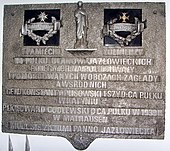 Memorial of the 14th Jazlowiec Uhlan Regiment
Memorial of the 14th Jazlowiec Uhlan Regiment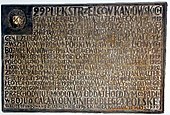 Plaque to the 29th Kaniów Rifle Division
Plaque to the 29th Kaniów Rifle Division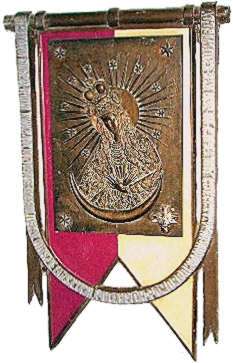 Our Lady of the Gate of Dawn banner tablet of the 1st Krechowce Uhlan Regiment
Our Lady of the Gate of Dawn banner tablet of the 1st Krechowce Uhlan Regiment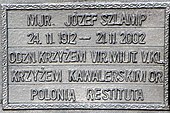 Plaque in memory of maj. Józef Szlamp
Plaque in memory of maj. Józef Szlamp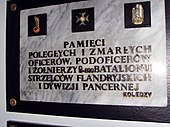 Memorial to the 9th Battalion of the Flanders Anti-Tank Rifles
Memorial to the 9th Battalion of the Flanders Anti-Tank Rifles
See also
References
- Antonia Brodie, British Architectural Library, Royal Institute of British Architects – 2001
- P.Best, M.Reczek, A.Suchcitz, Kronika Kościoła Św. Andrzeja Boboli w Londynie 1961-2011, Polska Misja Katolicka, Londyn 2012, ISBN 978-0957458208
- "25-lecie kościoła św. Andrzeja Boboli i uczczenie pamięci śp. ks. Kazimierza Sołowieja". Biuletyn. Koło Lwowian w Londynie (Nr 52): 51. January 1987.
- Andrzej Suchcitz. "Kazimierz Sołowiej" (in Polish). ipsb.nina.gov.pl. Retrieved 15 April 2019.
- Cherry, Bridget; Pevsner, Nikolaus (2002). Pevsner, Niklaus (ed.). London 3: North West Buildings of England Volume 3 of London, Nikolaus Pevsner Volume 3 of London, Simon Bradley (Architectural historian). Pevsner Architectural Guides: Buildings of England - The Buildings of England, Ireland, and Scotland Series. Yale University Press. p. 207. ISBN 9780300096521.CS1 maint: uses authors parameter (link)
- "Sanktuarium" (in Polish). bobola.church/pl. Retrieved 26 June 2017.
- "Polish Church 2 – St. Andrew Bobola". taking-stock.org.uk. Retrieved 26 June 2017.
- HFHBG Local List. London: Hammersmith and Fulham Historic Buildings Group. 2004. p. 150., Local List, 4th Edition, revised September 2004, p. 72
- "Polish Church wins Hammersmith Society Award". Hammersmith Today. 23 May 2008. Retrieved 16 July 2020.
- "Ksiądz Prałat Bronisław Gostomski" [Monsignor Bronisław Gostomski] (in Polish). bobola.church/pl. Retrieved 26 June 2017.
- "Local priest among victims of Polish plane crash". Hammersmith Today. 11 April 2010. Retrieved 8 December 2019.
- "Tablica „Orląt"". Biuletyn. Koło Lwowian w Londynie (Nr 3): 9. November 1962.
- "Pamięci gen. Waleriana Czumy". Biuletyn. Koło Lwowian w Londynie (1 (6)): 59–63. May 1964.
- "Kronika. Ziemia z grobów katyńskich w kościele św. Andrzeja Boboli w Londynie" [Soil from the graves of the Katyn victims in St Andrew Bobola church]. Biuletyn (Bulletin). Koło Lwowian w Londynie (Circle of Kresy deportees) (Nr 34): 83. June 1978.
- "St Andrew Bobola Churchyard". London Gardens Online. Retrieved 8 December 2019.
- Maria Leśniak (22 October 1978). "Listy do redakcji" [Letters to the Editor]. Wiadomości: 4.